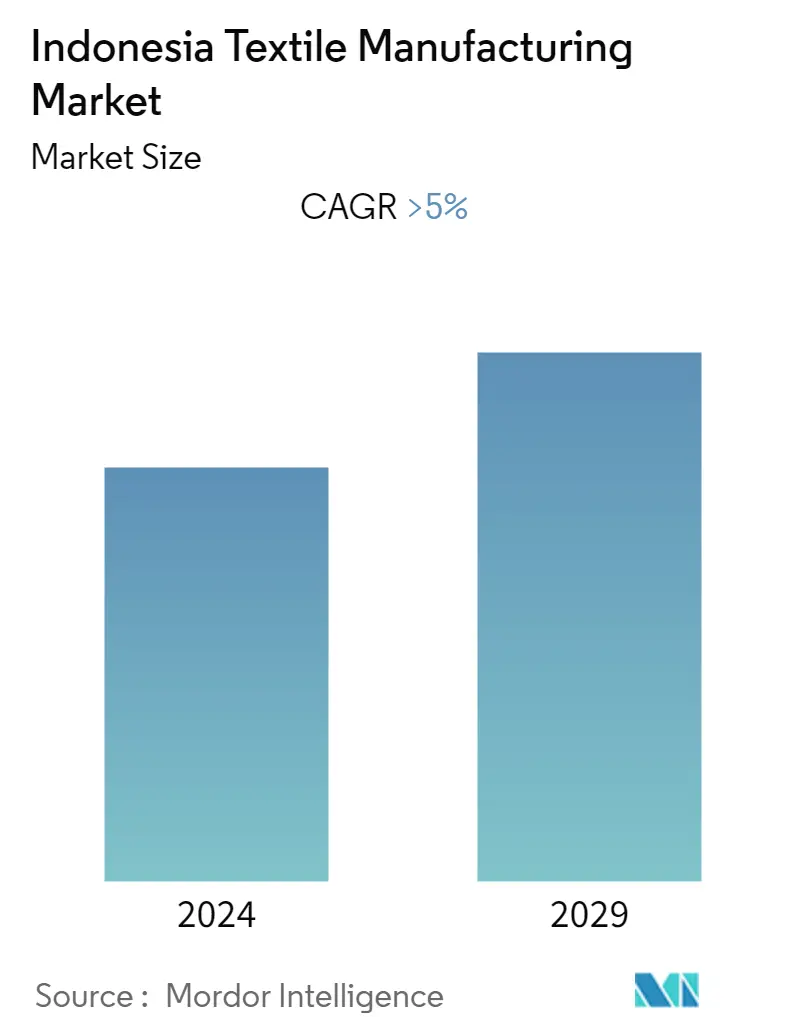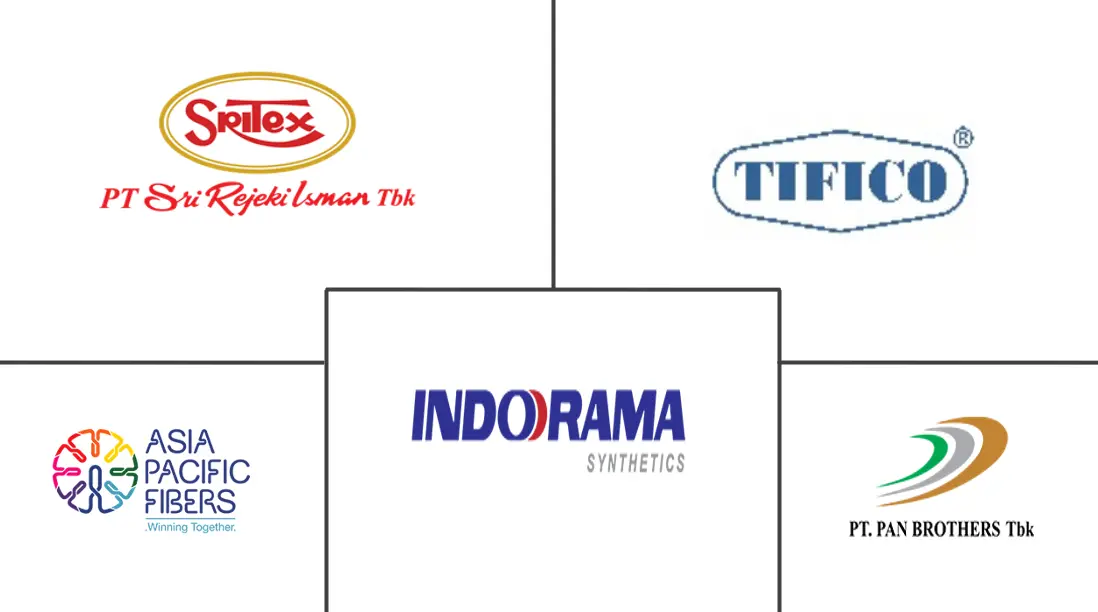Market Size of Indonesia Textile Manufacturing Industry

| Study Period | 2020 - 2029 |
| Base Year For Estimation | 2023 |
| Forecast Data Period | 2024 - 2029 |
| Historical Data Period | 2020 - 2022 |
| CAGR | 5.00 % |
| Market Concentration | Low |
Major Players
*Disclaimer: Major Players sorted in no particular order |
Indonesia Textile Manufacturing Market Analysis
The Indonesia Textile Manufacturing Market is expected to record a CAGR of greater than 5% during the forecast period (2023-2028).
- Indonesia's push to new export markets, leveraging its ties with Muslim nations, is also contributing to development. Several Muslim-majority nations now account for half of Indonesia's trade missions and discussions, and textiles are now heavily exported there. As clothing manufacturers continue to relocate manufacturing away from China, Indonesia offers an appealing option. China's worldwide cotton imports are declining, and most cotton exports are being channeled to competitive nations such as Indonesia. China's cotton imports are expected to climb by just 3.5 million bales between 2021 and 2030, compared to an anticipated 8.1 million bales for the major rival garment nations, Indonesia, Vietnam, Pakistan, Bangladesh, and Turkey combined.
- An increase in exportation to major countries like the United States, the European Nations, and the Middle East has led to the rapid development of the Textile Manufacturing Industry. High dependency on imported raw materials is likely to act as a restraint for the market. To expand the Indonesian Textile Manufacturing Industry, the Indonesian government has encouraged Textile Product Industry ( TPT ) to explore the fashion industry and meet its demand, which will open many new opportunities for this industry during the forecast period.
- Companies in the industry can profit from high-quality products, substantial government backing, and cheap labor costs. Nonetheless, outdated gear and a reliance on imported raw materials result in lower manufacturing costs. Companies looking to enter the textile and apparel manufacturing sector in Indonesia will discover significant development potential in an already robust market.
Indonesia Textile Manufacturing Industry Segmentation
Textile refers to materials that are made from fibers, thin threads, or filaments that are natural or manufactured, or a combination. Textiles are created by interlocking these yarns in specific patterns resulting in a length of cloth. The textile fibers are spun into yarn and then made into fabric by different methods like weaving, knitting, and felting.
The Indonesian textile manufacturing market is segmented by textile type (fiber, yarn, fabric, garment, and other textiles ), process type (spinning, weaving, knitting, finishing, and other process types), and machinery type (simple machines, automated machines, and console/ assembly line installations).
The report offers market size and forecast for Indonesia Textile Manufacturing Market value (USD Billion) for all the above segments. The report also covers the impact of COVID-19 on the market.
| By Process Type | |
| Spinning | |
| Weaving | |
| Knitting | |
| Finishing | |
| Other Process Types |
| By Textile Type | |
| Fiber | |
| Yarn | |
| Fabric | |
| Garments | |
| Other Textile Types |
| By Equipment and Machinery | |
| Simple Machines | |
| Automated Machines | |
| Console/Assembly Line Installations |
Indonesia Textile Manufacturing Market Size Summary
The Indonesian textile manufacturing industry is poised for significant growth, driven by its strategic expansion into new export markets, particularly within Muslim-majority countries. This shift is bolstered by Indonesia's strong ties with these nations, which now represent a substantial portion of its trade activities. As global clothing manufacturers seek alternatives to China, Indonesia emerges as a compelling option due to its competitive advantages, including government support, low labor costs, and a burgeoning domestic market. The industry is also benefiting from increased exports to major markets such as the United States, Europe, and the Middle East, although it faces challenges due to its reliance on imported raw materials. The Indonesian government's encouragement for the Textile Product Industry to explore the fashion sector presents new opportunities for growth during the forecast period.
Indonesia's textile sector is a crucial component of the nation's manufacturing landscape, contributing significantly to its production output and export value. The country ranks among the top ten global exporters of textiles and textile products, with substantial shipments to regions like the Middle East and Africa. The industry's growth is further supported by economic stability, rapid urbanization, and rising disposable incomes, which are driving demand for diverse textile varieties. The market is characterized by a high degree of fragmentation, with numerous local and international players, including key companies like PT. Asia Pacific Fibers Tbk and Indorama Corporation. Collaborative efforts, such as those between Toray Industries and Soramitsu, aim to enhance sustainability and traceability within the supply chain, reflecting a broader trend towards integrating sustainable practices in the industry.
Indonesia Textile Manufacturing Market Size - Table of Contents
-
1. MARKET INSIGHTS AND DYNAMICS
-
1.1 Market Overview
-
1.2 Market Drivers
-
1.3 Market Restraints/Challenges
-
1.4 Market Opportunities
-
1.5 Value Chain/Supply Chain Analysis
-
1.6 Porter's Five Forces Analysis
-
1.6.1 Threat of New Entrants
-
1.6.2 Bargaining Power of Buyers/Consumers
-
1.6.3 Bargaining Power of Suppliers
-
1.6.4 Threat of Substitute Products
-
1.6.5 Intensity of Competitive Rivalry
-
-
1.7 Technological Innovations in the industry
-
1.8 Impact of COVID - 19 on the Industry
-
1.9 Government Initiatives to Attract Investment in the Industry
-
-
2. MARKET SEGMENTATION
-
2.1 By Process Type
-
2.1.1 Spinning
-
2.1.2 Weaving
-
2.1.3 Knitting
-
2.1.4 Finishing
-
2.1.5 Other Process Types
-
-
2.2 By Textile Type
-
2.2.1 Fiber
-
2.2.2 Yarn
-
2.2.3 Fabric
-
2.2.4 Garments
-
2.2.5 Other Textile Types
-
-
2.3 By Equipment and Machinery
-
2.3.1 Simple Machines
-
2.3.2 Automated Machines
-
2.3.3 Console/Assembly Line Installations
-
-
Indonesia Textile Manufacturing Market Size FAQs
What is the current Indonesia Textile Manufacturing Market size?
The Indonesia Textile Manufacturing Market is projected to register a CAGR of greater than 5% during the forecast period (2024-2029)
Who are the key players in Indonesia Textile Manufacturing Market?
PT Asia Pacific Fibers TBK, Indo - Rama synthetics TBK, PT Sri Rejeki Isman TBK, PT Tifico Fiber Indonesia TBK and PT Pan Brothers TBK are the major companies operating in the Indonesia Textile Manufacturing Market.

